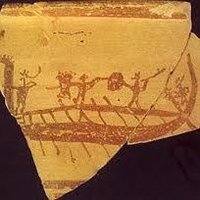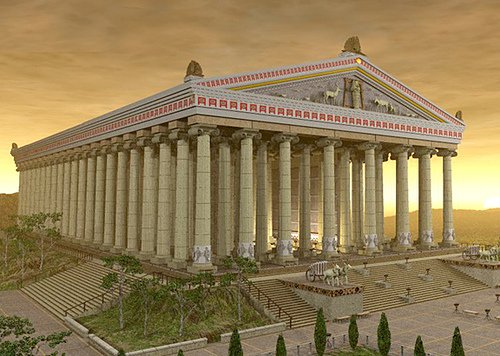1/ Miletus was in ancient times one of the most important cities of Ionia with intense political, commercial, colonial and cultural activity, located under the roof of Didyma Apollo, who was worshiped in one of the most famous oracles of the ancient Greek world.
2/Due to its important geographical position on the SW coast of Western Anatolia,opposite Samos and near the mouth of the important Meander River, Miletos attracted interest already in the Chalcolithic Period,constituting a bridge of communication between the Aegean and Anatolia.
3/ The initial habitation in Miletus was located in the area of the later classical temple of Athena and goes back to the Late Chalcolithic Period (3500-3200 BC). 

 The excavations have brought to light a typical stone-built storage building together with coarse domestic and more refined pottery; all belonging to a common cultural group that included the FN of the Eastern Aegean and the Late Chalcolithic of Anatolia.
The excavations have brought to light a typical stone-built storage building together with coarse domestic and more refined pottery; all belonging to a common cultural group that included the FN of the Eastern Aegean and the Late Chalcolithic of Anatolia. 4/ The finding of numerous blades of excellent quality Melian obsidian makes an impression, which indicates close relations with the Cyclades and 

 the existence in Miletus of a hub for the promotion of Melian obsidian to Anatolia, where relevant findings have been found, with this activity continuing to the EBA.
the existence in Miletus of a hub for the promotion of Melian obsidian to Anatolia, where relevant findings have been found, with this activity continuing to the EBA. 5/ However, as far back as the Early Bronze Age there is a sharp rise in the local sea level, which reached its highest point during the late EBA II and III phase resulting in the creation of an archipelago-type coastal landscape 

 and the habitation to be moved inland to higher points, as well as to two islets that had formed at a distance of 300-400 meters from the coastline.
and the habitation to be moved inland to higher points, as well as to two islets that had formed at a distance of 300-400 meters from the coastline. 6/ In this particular period, Miletus was a developed community with sophisticated social and economic structures, maintaining strong ties with the Aegean (Cyclades-Crete), both commercial (EM II/III and EC III imports) and symbolic (Cycladic seated marble figurines).
7/ However, during the Middle Bronze Age we have an important change in Miletus which consists in the fact of the intense Minoan presence already from the Protopalatial Period in the form of a Minoan trading station that promoted Cretan products to Anatolia.
8/ At the same time, however, the presence of an important Anatolian population element is indicated, which demonstrates characteristic features of cultural continuity with the previous period of the Early Bronze Age (ceramic patterns).
9/ During the Minoanising Phase and specifically until the Theran eruption, a complex of rectangular buildings with pottery workshops and cult spaces was created in the area of the Temple of Athens, where Aegean imports are abundant, although mixed with local ceramics.
10/ Especially during the Miletus IVa phase (LM IA) the city experienced great growth with the influx of great wealth that led to the construction of extensive new rectangular buildings, 

 as well as a large cult sanctuary with 6 altar platforms and 15 stationary plaster offering tables, where animal sacrifices and ritual symposiums took place.
as well as a large cult sanctuary with 6 altar platforms and 15 stationary plaster offering tables, where animal sacrifices and ritual symposiums took place. 11/ It seems that the Meander river trade route brought the Minoan traders to this area with Miletus gaining an important position in the Minoan presence in Western Anatolia, 

 bringing high-quality pottery and elaborate luxury objects from Crete and the Cyclades, which had main use by the inhabitants of Miletus and not supplementary.
bringing high-quality pottery and elaborate luxury objects from Crete and the Cyclades, which had main use by the inhabitants of Miletus and not supplementary. 12/ Miletos was dramatically affected by the Theran eruption, but is being repopulated and very well preserved architectural elements are preserved in a context of continued Minoan influence. 

 However, at the end of the phase Miletus IVb there are signs of destruction by Mycenaean raiders, who establish a stable strong Mycenaean presence in Miletus.
However, at the end of the phase Miletus IVb there are signs of destruction by Mycenaean raiders, who establish a stable strong Mycenaean presence in Miletus. 13/ Thus we have the appearance of the First Mycenaeanising Phase with the existence of family pottery workshops, the reduction of imports from the Aegean islands with the simultaneous presence of large quantities of Argolic pottery and figurines 

 and a clear change in the diet habits of the inhabitants. The archaeological findings combined with references in the Hittite texts present a picture of the integration of Miletus in the Mycenaean territory.
and a clear change in the diet habits of the inhabitants. The archaeological findings combined with references in the Hittite texts present a picture of the integration of Miletus in the Mycenaean territory. 14/ The Second Mycenaeanising Phase follows with the construction of the Corridor Houses, where the presence of Mycenaean population groups in Miletus is indicated, who built a strong fortification wall and buried their dead in Mycenaean chambered tombs within a necropolis.
15/Mycenaean Miletus was very extensive residentially and functioned as an advanced political,military and commercial enclave of the Achaeans in W. Anatolia,as well as an area of constant friction with the Hittites, since it was the starting point of aggressive Mycenaean actions.
16/ Of particular interest is the record of a group of textile industry female workers originally from Miletos (mi-ra-ti-ja) in the Pylos tablets archive, where they appear in lists of rations as dependent workers together with their children, 

 demonstrating that Miletos was a trading center for the exchange of helladic products with other products from Anatolia, as well as slaves.
demonstrating that Miletos was a trading center for the exchange of helladic products with other products from Anatolia, as well as slaves. 17/ Miletus suffered a heavy blow during the early LH IIIC, as reflected in an extensive level of destruction, the product of raiding by the Sea Peoples. However, the Mycenaean control over Miletus had already ended by the first decade of Tuhdaliya VI's reign (>1230 BC).
18/ However, during the Sub-Mycenaean period (1050 BC), Miletus received the first Ionian settlers, who according to ancient Greek tradition came from Attica, while it is implied that they were actually descendants of refugees from the former Mycenaean kingdom of Pylos.
19/ The ancient sources state that the Ionians arrived in Miletus not as peaceful settlers looking for a new life taking their families and belongings with them, but as sea raiders, who slaughtered the local male population (mainly Carians) and married the their wives.
20/ Be that as it may, a strong Greek city was created, which emerged as a leading power of the Ionian League, became the metropolis of many colonies, allying with Megara, 

 got involved in the issues of the Greek city-states, taking part in the Lelantine War (8th century BC) and mainly highlighted leading figures of the ancient Greek spirit (Thales, Anaximander, Anaximenes).
got involved in the issues of the Greek city-states, taking part in the Lelantine War (8th century BC) and mainly highlighted leading figures of the ancient Greek spirit (Thales, Anaximander, Anaximenes). 
Hermahai
@hermahai
Threads about Aegean Prehistory and Protohistory, as well as presentation of cultural parallels outside the Aegean Basin.
Missing some tweets in this thread? Or failed to load images or videos? You can try to .








































